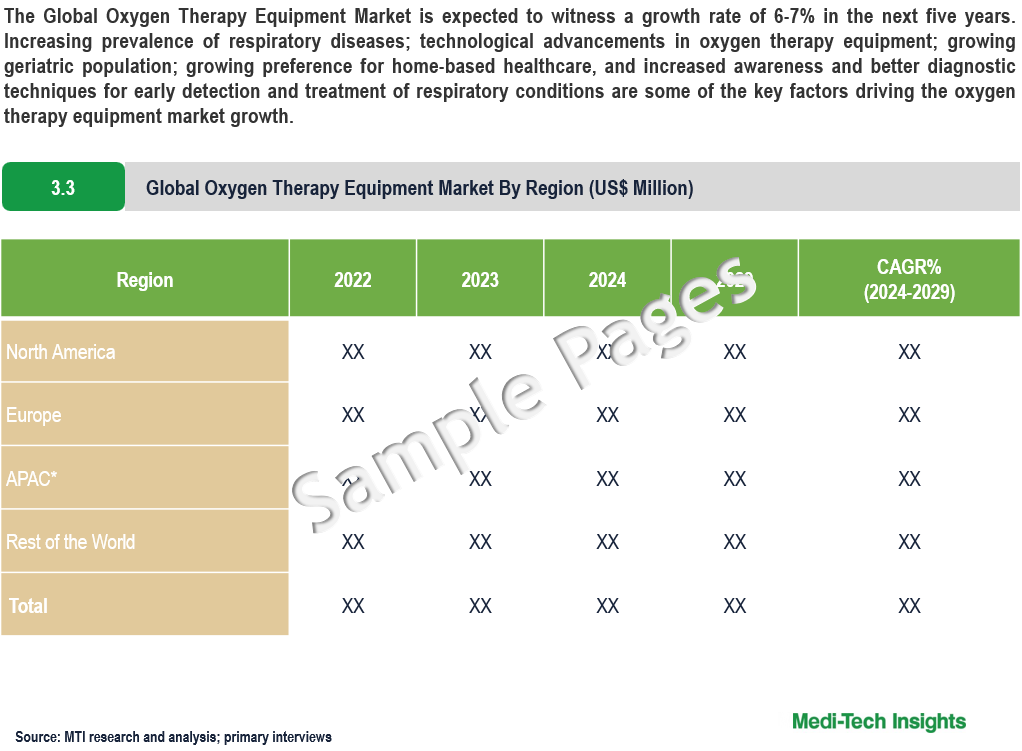
Oxygen Therapy Equipment Market Size, Share, Growth Analysis, Industry Trends & Demand for Forecast by 2029
The Global Oxygen Therapy Equipment Market is expected to witness a growth rate of 6-7% in the next five years. Increasing prevalence of respiratory diseases; technological advancements in oxygen therapy equipment; growing geriatric population; growing preference for home-based healthcare, and increased awareness and better diagnostic techniques for early detection and treatment of respiratory conditions are some of the key factors driving the oxygen therapy equipment market growth. However, high costs of advanced oxygen therapy equipment; stringent regulatory approvals and compliance requirements, inadequate reimbursement policies, and technical issues and complications associated with oxygen therapy equipment are likely to hinder the market’s growth. To learn more about the research report, download a sample report.
Oxygen therapy equipment refers to medical devices designed to provide supplemental oxygen to individuals with respiratory conditions or insufficient oxygen levels. Oxygen therapy equipment includes oxygen source equipment like oxygen cylinders, oxygen concentrators, liquid oxygen, system, PAP devices, and accessories such as nasal cannulas, and masks, among others. The choice of equipment depends on the patient's needs, lifestyle, and activities, and proper education and monitoring are crucial for effective use.
Increasing Prevalence of Respiratory Diseases to Drive Market Growth
Conditions such as Chronic Obstructive Pulmonary Disease (COPD), asthma, and pulmonary fibrosis are on the rise due to factors like pollution, smoking, and aging populations. Patients with these chronic diseases often require long-term oxygen therapy to maintain adequate blood oxygen levels. The increasing prevalence of respiratory diseases is a significant factor driving the growth of the oxygen therapy equipment market. This trend is primarily driven by the rising cases of chronic obstructive pulmonary disease (COPD), asthma, and other respiratory disorders. According to World Health Organization (WHO) chronic obstructive pulmonary disease (COPD) is the third leading cause of death worldwide, causing 3.23 million deaths in 2019, while an estimated 17.9 million people died from CVDs in 2019, representing 32% of all global deaths. As the global prevalence of these diseases increases, largely due to aging populations, lifestyle factors, and environmental issues, the demand for oxygen therapy equipment is rising.
“Oxygen therapy has expanded from inpatient to outpatient settings, with patients with chronic pulmonary diseases and hypoxemia requiring oxygen support. Conditions such as COPD, pulmonary fibrosis, and cystic fibrosis often necessitate supplemental oxygen to maintain normal organ function"- Pulmonologist, Leading Academic Medical Center, United States
Growing Geriatric Population to Fuel Market Growth
The growing geriatric population is a significant driver of market growth for oxygen therapy equipment. As people age, their respiratory function typically declines, making them more susceptible to chronic respiratory diseases such as COPD, asthma, and pneumonia. These conditions often require long-term oxygen therapy to manage symptoms and maintain adequate oxygen levels in the blood. Older adults are more likely to develop comorbidities that exacerbate respiratory issues, further increasing the demand for oxygen therapy. The aging population trend is particularly pronounced in developed countries, where life expectancy is higher due to advanced healthcare systems. This demographic shift creates a larger patient base needing consistent oxygen therapy, both in clinical settings and at home. Additionally, the elderly population prefers home-based healthcare to maintain their independence and comfort. Oxygen therapy equipment, such as portable oxygen concentrators, caters to this preference by providing convenient, reliable oxygen delivery at home. This trend reduces the need for hospital admissions and prolonged stays, making home oxygen therapy a cost-effective solution for healthcare systems. The increasing prevalence of chronic respiratory diseases, combined with the aging global population, ensures sustained demand for oxygen therapy equipment, driving market growth significantly.
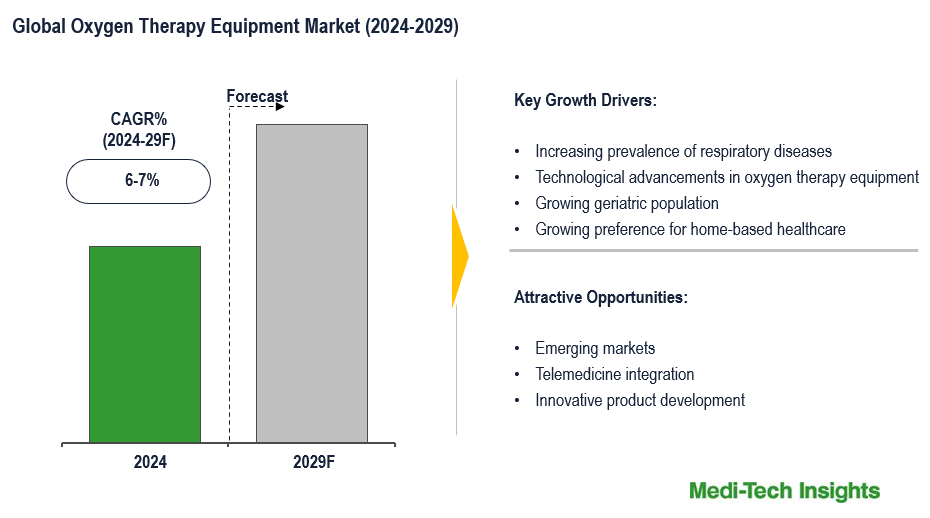
To learn more about this report, download the PDF brochure
Technological Innovations are Driving the Oxygen Therapy Equipment Market
The oxygen therapy equipment market is technology-driven and is marked by constant product innovations. For instance,
- In July 2023, VARON a leading oxygen concentrator manufacturer, launched VP-2, a portable oxygen concentrator that incorporates innovative technology and advanced features to provide efficient and reliable oxygen therapy to patients on-the-go
- In July 2022, OMRON Healthcare launched the OxyHome 5L Stationary Concentrator, a new product that provides a continuous oxygen flow of up to 5L per minute for home use, catering to the needs of patients requiring high-flow oxygen therapy
- In April 2019, Inogen, Inc. launched its innovative Inogen One G5 portable oxygen concentrator, a lightweight and innovative device that provides high oxygen output and features like long battery life, quiet operation, and patient-preferred design
US Expected to be a Major Growth Engine in Oxygen Therapy Equipment Market
US is expected to be a major growth engine in the oxygen therapy equipment market. The country has a well-established healthcare infrastructure, which drives the demand for advanced medical devices. The high prevalence of chronic respiratory diseases such as COPD and asthma contributes to the growth of the market. According to the Centers for Disease Control and Prevention (CDC) an estimated 14.2 million (6.5%) US adults had physician-diagnosed COPD in 2021. Additionally, the increasing adoption of home-based oxygen therapy and the rising demand for portable oxygen concentrators are expected to fuel the market growth in the US. Furthermore, the country's favourable reimbursement policies and high healthcare expenditure also support the growth of the oxygen therapy equipment market.
Product Type Segment Analysis
The oxygen source equipment segment dominated the market in 2022 due to its widespread availability and utilization in oxygen concentrators, compressed gas systems, cylinders, and liquid oxygen. Portable oxygen concentrators are expected to grow significantly due to their use in medical emergencies and ambulances. Technological advancements in oxygen source and delivery devices, such as flow regulating devices and sensors, are also driving growth. The demand for portable oxygen concentrators is increasing due to their adoption in emergency medicine and the need for greater mobility support for the geriatric population.
The oxygen delivery devices segment is expected to grow due to the availability of various devices meeting different patient needs, while oxygen masks are expected to grow steadily due to their importance in the oxygen delivery system.
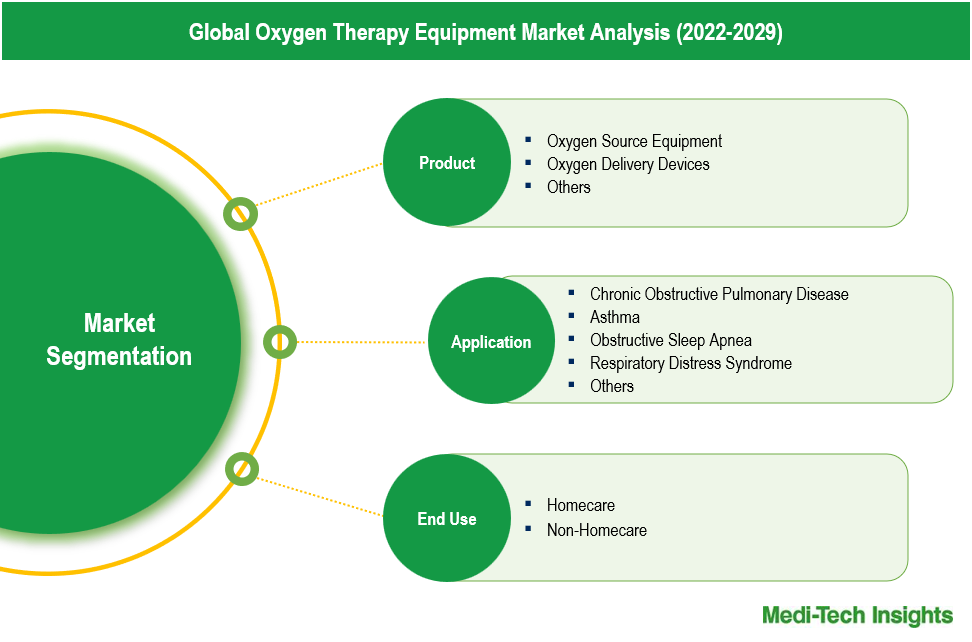
To learn more about this report, download the PDF brochure
Application Type Segment Analysis
The oxygen therapy equipment market can be analyzed based on application types, such as chronic obstructive pulmonary disease, asthma, obstructive sleep apnea, respiratory distress syndrome, and others. The COPD segment is likely to dominate the dominated the market due to the increasing incidence of COPD, which affects approximately 65 million people worldwide and is the third leading cause of mortality. Asthma is likely to hold the second-largest share, with evolving O2 treatment modalities expected to drive future growth. The sleep apnea segment is anticipated to witness exponential growth due to the utilization of nocturnal oxygen therapy and supplemental O2 administration with CPAP devices. The respiratory distress syndrome segment is expected to exhibit a moderate growth rate due to the rising prevalence in premature birth and the need for effective treatment alternatives
Organic and Inorganic Growth Strategies Adopted by Players to Establish Their Foothold in the Market
Players operating in this market are adopting both organic and inorganic growth strategies such as collaborations, acquisitions, and new product launches to garner market share. For instance,
- In March 2024, Drive DeVilbiss Healthcare Sanrai International launched PulmO2 10L, a new generation of oxygen concentrator for providing oxygen to patients that need life-saving oxygen across the world, particularly in low-resource environments
- In July 2023, Inogen, Inc. acquired Physio-Assist SAS, a French company that developed the Simeox airway clearance device, which is used to treat bronchiectasis, a condition often present in cystic fibrosis and chronic obstructive pulmonary disease
- In January 2023, CAIRE Inc., acquired MGC Diagnostics Holdings, Inc. to strengthen its position in diagnostic technologies and expand its expertise in serving patients with pulmonary disease
The oxygen therapy equipment market is expected to gain further momentum in the coming years due to technological advancements, rising R&D investments, new product launches, and aggressive organic and inorganic growth strategies followed by the players.
Competitive Landscape Analysis: Oxygen Therapy Equipment Market
The global Oxygen Therapy Equipment market is marked by the presence of established market players such as Koninklijke Philips N.V., GE Healthcare, Hersill, Fisher & Paykel Healthcare, Invacare Corporation, ResMed, Teleflex Incorporated, Linde plc, Drägerwerk AG & Co. KGaA, and Inogen, Inc., among others.
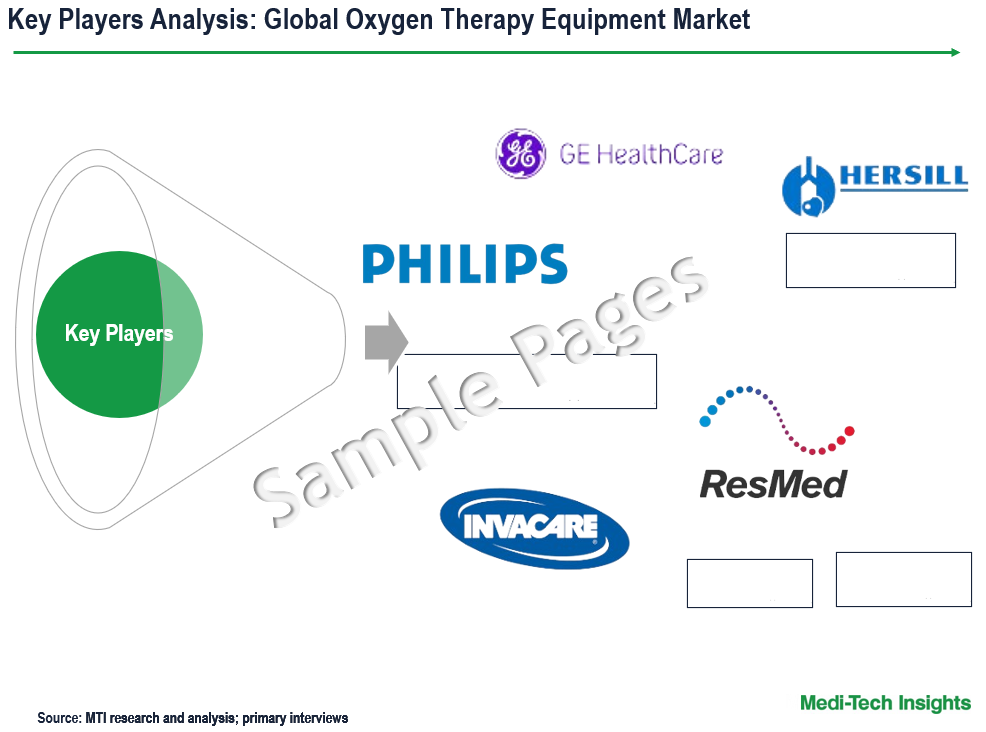
Get a sample report for competitive landscape analysis
Future Outlook of the Oxygen Therapy Equipment Market
The global oxygen therapy equipment market is expected to gain further momentum in the coming years due to the increasing incidence of tobacco smoking globally, increasing demand for home healthcare and portable oxygen concentrators, and expanding applications of oxygen therapy in emergency medicine and critical care. These factors collectively contribute to the growth and evolution of the oxygen therapy equipment market.
Oxygen Therapy Equipment Market Futures and Scope
| Report Scope | Details |
| Base Year Considered | 2023 |
| Historical Data | 2022 - 2023 |
| Forecast Period | 2024 - 2029 |
| CAGR (2024-2029) | 6-7% |
| Segment Scope | Product, Application, End User |
| Regional Scope |
|
| Key Companies Mapped | GE Healthcare, Hersill, Koninklijke Philips N.V., Fisher & Paykel Healthcare, Invacare Corporation, ResMed, Teleflex Incorporated, Linde plc, Drägerwerk AG & Co. KGaA, and Inogen, Inc., among others |
| Report Highlights | Market Size & Forecast, Growth Drivers & Restraints, Trends, Competitive Analysis |
Key Strategic Questions Addressed
-
What is the market size & forecast for the Global Oxygen Therapy Equipment Market?
-
What are the historical, present, and forecasted market shares and growth rates of various segments and sub-segments of the Global Oxygen Therapy Equipment Market?
-
How has COVID-19 impacted the Global Oxygen Therapy Equipment Market?
-
What are the major growth drivers, restraints/challenges impacting the market?
-
What are the opportunities prevailing in the market?
-
What is the investment landscape?
-
Which region has the highest share in the global market? Which region is expected to witness the highest growth rate in the next 5 years?
-
Who are the major players operating in the market? What is the competitive positioning of key players?
-
Who are the new players entering the market?
-
What are the key strategies adopted by players?
- Research Methodology
- Secondary Research
- Primary Research
- Market Estimation
- Market Forecasting
- Executive Summary
- Market Overview
-
- Market Dynamics
- Drivers
- Restraints
- Key Market Trends
- Industry Speaks
- Market Dynamics
- Key Revenue Pockets
- Global Oxygen Therapy Equipment Market - Size & Forecast (2021-2028), By Product Type
- Oxygen Source Equipment
- Oxygen Cylinders
- Oxygen Concentrators
- Liquid Oxygen System
- Pap Devices
- Oxygen Delivery Devices
- Oxygen Masks
- Nasal Cannula
- Venturi Masks
- Non-Rebreather Masks
- Bag Valve Masks
- Cpap Masks
- Others
- Oxygen Source Equipment
- Global Oxygen Therapy Equipment Market - Size & Forecast (2021-2028), By Application Type
- Asthma
- Obstructive Sleep Apnea
- Respiratory Distress Syndrome
- Cystic Fibrosis
- Pneumonia
- Other Applications
- Global Oxygen Therapy Equipment Market - Size & Forecast (2021-2028), By End Use Type
- Homecare
- Non-Homecare
- Global Oxygen Therapy Equipment Market - Size & Forecast (2021-2028), By Region
- North America (U.S. & Canada)
- Europe (UK, Germany, France, Italy, Spain, Rest of Europe)
- Asia Pacific (China, India, Japan, Rest of Asia Pacific)
- Rest of the World (Latin America, Middle East & Africa)
- Competitive Landscape
- Key Players and their Competitive Positioning
- Competitive Positioning of Key Players (2022)
- Offerings Assessment, By Player
- Key Strategies Assessment, By Player (2021-2023)
- New Product & Service Launches
- Partnerships, Agreements, & Collaborations
- Mergers & Acquisitions
- Geographic Expansion
- Key Players and their Competitive Positioning
- Key Companies Scanned (Indicative List)
- Koninklijke Philips N.V.
- GE Healthcare
- Hersill
- Fisher & Paykel Healthcare
- Invacare Corporation
- ResMed, Teleflex Incorporated
- Linde plc
- Drägerwerk AG & Co. KGaA
- Inogen, Inc.
- Other Prominent Players
The study has been compiled based on extensive primary and secondary research.
Secondary Research (Indicative List)

Primary Research
To validate research findings (market size & forecasts, market segmentation, market dynamics, competitive landscape, key industry trends, etc.), extensive primary interviews were conducted with both supply and demand-side stakeholders.
Supply Side Stakeholders:
- Senior Management Level: CEOs, Presidents, Vice-Presidents, Directors, Chief Technology Officers, Chief Commercial Officers
- Mid-Management Level: Product Managers, Sales Managers, Brand Managers, Business Development Managers, Consultants
Demand Side Stakeholders:
- Stakeholders in Hospitals, Intensive Care Units, Home healthcare providers, Pulmonologists and Other Stakeholders
Breakdown of Primary Interviews
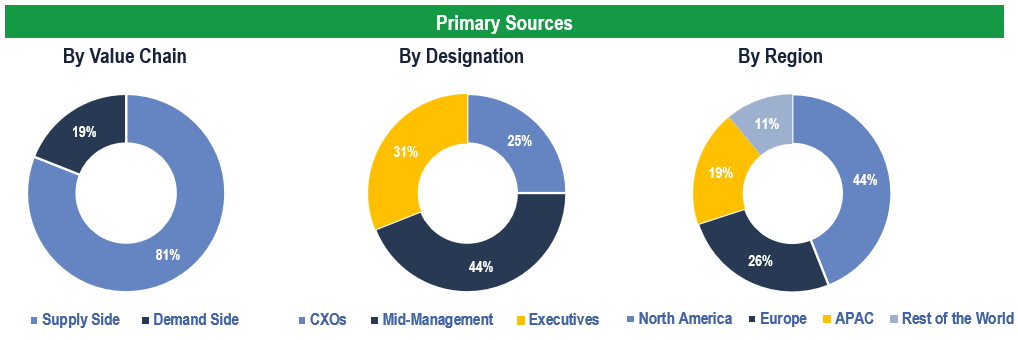
Market Size Estimation
Both ‘Top-Down and Bottom-Up Approaches’ were used to derive market size estimates and forecasts.
Data Triangulation
Research findings derived through secondary sources & internal analysis were validated with Primary Interviews, Internal Knowledge Repository, and Company Sales Data.

